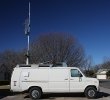|
Using a GPS device to find direction |
 |
 |
 |
|
Written by Rick Kirchhof, NG5V
|
|
Thursday, 17 June 2010 22:38 |
|
All bearings in this FAQ are described as degrees TRUE (referenced to geographic North). Declination must be corrected if using a magnetic reading before you can talk about a true bearing.
Mapping and prep work is very important when making distant links to other mesh nodes. Other tools elsewhere on this site can help you determine if location A can "see" location B. Site selection, antennas and computers/software are all part of it as well. One problem that often occurs is determining exactly which direction to point your antenna to aim at the distant mesh node. The quick answer usually is something like "I'll just look at my compass". That is somewhat more complex than it seems. First, you have to be familiar with using a compass. Second, you have to determine your declination value and properly apply it. Third, you have to be several feet away from magnetic equipment including anything heavy you might be carrying with you. There may also be distortions from underground features or electric devices nearby. Not all compass models are easy to read accurately. Click each link above for help using a compass.
Great, now you know how to use a compass. But where exactly are you? Your site research said that latitude x at longitude y is high enough to see the distant site you want to aim toward. Your location can be directly read from your hand-held GPS device but you still need to know which direction to aim. This is easy to do. Set your GPS device into a mode that shows the bearing you are traveling. Usually this is a combination screen showing speed and direction (bearing true). You can find the bearing to any distant point by walking very briskly in a straight line toward that spot. Always start walking from the exact location of your antenna. After walking at least 20 feet, look down at the bearing. This is the direction (true) from your antenna to where you were walking. You can try this several times in different directions to get a specific number. Once you have that result, aim your antenna toward that point and begin trying to link with the distant mesh node.
It helps to have a compass rose as a part of your antenna aiming device. Once you determine any given bearing, swing the rose around to match its bearing with the actual direction and you have a direct-reading aiming process. This is how fire tower telescope spotters work. Here is a copy of a compass rose you can print and laminate. Right click on the image and "save as" to produce a local copy, or you can just print it. Integrating it into your tripod mount is a task left to the user.
|
|
Last Updated on Friday, 18 June 2010 00:28 |



